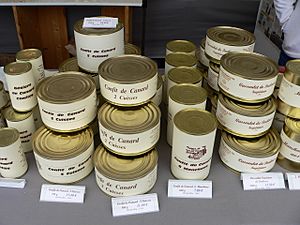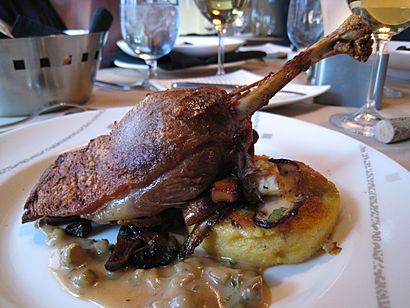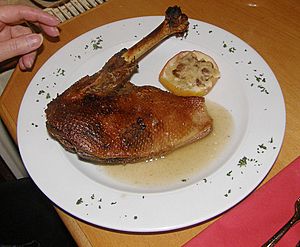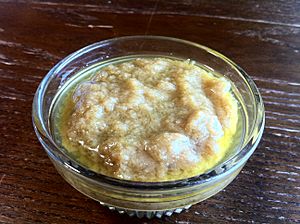Confit facts for kids
Confit (pronounced "kon-fee") is a special way of cooking food very slowly. The word comes from French and means "to preserve." It's a method used to keep food fresh for a long time, especially before refrigerators were common!
When you make confit, food is cooked in oil, fat, or sugary syrup at a low temperature. Think of it like a gentle simmer, not a fast, hot fry. For example, deep frying uses very hot oil (around 160-230°C), but confit uses much cooler oil, often around 90°C or even less. This slow cooking makes the food super tender and flavorful.
For meats, like duck or goose, the meat is first salted. After cooking slowly in its own fat, it can stay good for many months or even years if stored properly in a cool, dark place. Confit is a famous cooking style from southwestern France.
Contents
What Does "Confit" Mean?
The word "confit" comes from the French verb confire. This means "to preserve" or "to candy." The French word itself came from an older Latin word, conficere, which meant "to make" or "to prepare."
Long ago, in the Middle Ages, people first used the word "confit" to describe fruits that were cooked and kept fresh in sugar.
Types of Confit
Sweet Fruit Confit
Fruit confit is basically candied fruit. These are whole fruits, or pieces of fruit, that have been preserved in sugar. To make them last, the sugar needs to soak all the way into the fruit, even to its center.
Smaller fruits, like cherries, are easier to make into confit because the sugar can reach the middle quickly. Larger fruits, like melons, take a very long time and a lot of effort to candy completely. This is why you usually see smaller fruit confits, as they are less expensive to make.
Savory Meat Confit

Meat confit is often made with the legs of birds like goose (confit d'oie) or duck (confit de canard). First, the meat is rubbed with salt and herbs for flavor. Then, it's cooked very slowly while completely covered in its own melted fat. The temperature is kept low, usually not going above 85°C.
After cooking, the meat is stored in this fat once it cools down. This method helps preserve the meat without needing a refrigerator. You can also make confit with turkey or pork in a similar way.
Meat confit is a special dish from the southwest of France, in areas like Toulouse. It's often used in hearty meals like cassoulet, a rich stew.
History of Meat Confit
The idea of making meat confit started as a way to keep meat from spoiling before people had refrigerators. Traditional meats for confit include waterfowl, like geese and ducks, and also pork. Even duck gizzards are often cooked this way.
Different parts of southern France have their own favorite ways to make confit. The "Confit country" is a region in France where goose fat is commonly used for cooking. This is different from areas like Provence, where olive oil is more popular because olives grow there easily.
In some parts of Confit country, goose confit is very popular. It's used in classic dishes like cassoulet and garbure, which are filling meals with confit and beans. Other areas, like Saintonge, are known for duck confit, often served with potatoes.
While other meats can be cooked using the confit process, the French usually only call duck and goose confit "true" confits. If chicken is cooked in goose fat, for example, it's called poulet en confit (chicken in confit). Pork is often cooked this way and then shredded to make a spread called rillettes.
Condiment Confit
Some types of confit are used as flavorings or condiments. In Italian cooking, for example, you might find onion confit, chili confit, or garlic confit. These are usually made by slowly cooking the ingredient in oil until it's very soft and flavorful.
See also
 In Spanish: Confit para niños
In Spanish: Confit para niños




